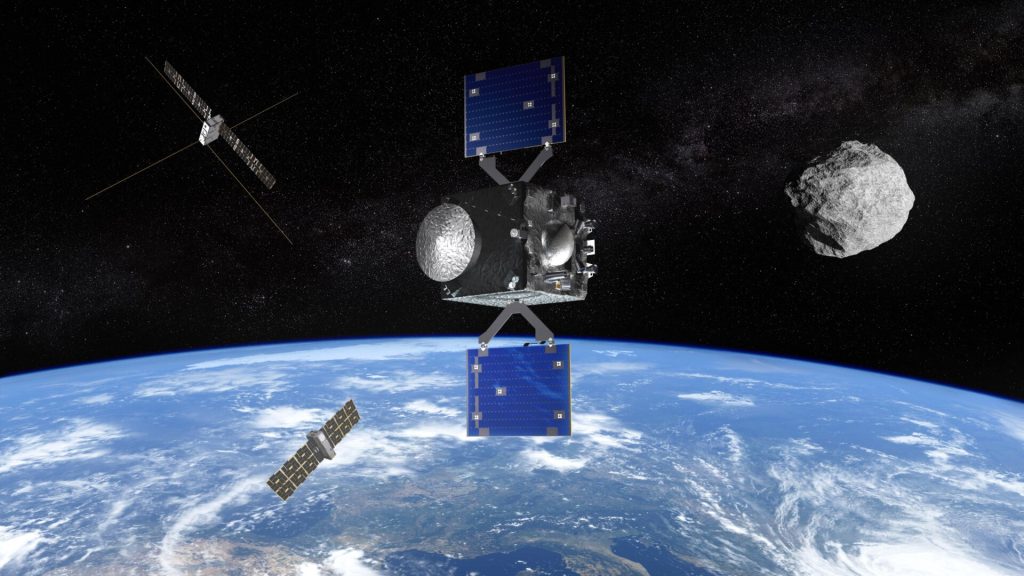The European Space Agency is preparing to send two spacecraft to track a potentially hazardous asteroid that could come close to Earth in 2029.
The Rapid Apophis Mission for Space Safety (Ramses) is planned to rendezvous with asteroid Apophis before it passes Earth and accompany it during the flyby on April 13, 2029. The spacecraft will study how Earth’s gravity changes the asteroid by comparing its shape, surface, orbit, rotation, and orientation before and after the flyby. Ramses will not only help scientists gain a better understanding of the solar system’s ancient space rocks, but it will also help Earth prepare for future asteroid impact threats.
ESA recently It was published The plan is to launch Ramses in April 2028. ESA has been given the go-ahead to begin preparatory work on the mission’s development, but a final decision on whether to fully commit to Ramses is due to be made at the ESA Ministerial Council meeting in November 2025.
Ramses will carry two CubeSats, which will be deployed from the main spacecraft upon arrival at the asteroid. The mission should arrive at Apophis in February 2029, two months before the asteroid’s close approach. Using a suite of scientific instruments, the two CubeSats will thoroughly observe the asteroid’s physical properties before and after the flyby. By analyzing how the asteroid changes upon impact with Earth, scientists hope to learn how these space rocks respond to external forces. The mission could also help scientists understand more about the asteroid’s composition, internal structure, cohesiveness, mass, density, and porosity.
“There is still a lot we don’t know about asteroids, but until now we have had to go deep into the solar system to study them, experiment on them ourselves, and interact with their surface,” Patrick Michel, director of research at the French National Center for Scientific Research, said in a statement. “For the first time, nature has brought an asteroid to us to experiment on itself. All we need to do is watch as Apophis is stretched and compressed by strong tidal forces, which could cause landslides and other disturbances that could expose new material from beneath the surface.”
Learning about asteroids could allow scientists to glean clues about the origin of planets in our solar system and how Earth and its neighbors have evolved over time — but it could also represent a first step in altering asteroids’ orbits, helping to prepare Earth for upcoming threats.
“Ramses will demonstrate that humanity can deploy a reconnaissance mission to rendezvous with a approaching asteroid in just a few years,” ESA’s Planetary Defence Director Richard Moisle said in a statement. “The reconnaissance mission will first be launched to analyse the trajectory and structure of the approaching asteroid. The results will be used to determine how best to redirect the asteroid, or to rule out possibilities of avoiding a collision, before expensive deflection missions are developed.”
Apophis is named after the enemy of the ancient Egyptian sun god Ra, an evil serpent who tries to swallow the stars that disappear from the sky each night, so it’s only fitting that ESA’s mission is named after one of the most famous pharaohs who ruled ancient Egypt during its Golden Age.
When it was first discovered in 2004, Apophis was designated a hazardous asteroid that could collide with Earth. However, subsequent observations have led scientists to conclude there is no need to panic just yet, and the asteroid is It’s not likely to collide with Earth for at least another century.The 1,100-foot (335-meter) wide near-Earth object will come within 20,000 miles (32,000 kilometers) of Earth in 2029.
Other scientists are trying to take advantage of how close Apophis is to Earth. NASA’s OSIRIS-APEX spacecraft (formerly OSIRIS-REx) is already In the process of studying Apophis The probe will observe the changes that the asteroid will undergo as it approaches Earth. The probe is scheduled to arrive at the asteroid in about five years. NASA hosts workshop The initiative calls for ideas from the private sector for innovative approaches to carry out the mission when the asteroid Apophis approaches Earth in 2029. In response, private space companies such as Blue Origin and startup Exploration Labs have Proposed rendezvous mission with Apophis Before the scheduled approach flight.
As the asteroid continues on its orbit towards Earth, it is hoped that further missions and research methods will be proposed to study the space rock during its approach.


